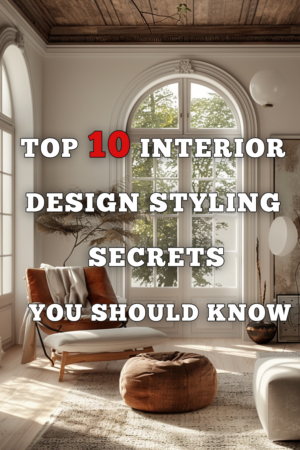
Unlock the full potential of your living spaces with these top 10 interior design styling secrets.
Whether you’re refreshing a room or embarking on a complete makeover, these design hacks will help you achieve a stunning aesthetic without breaking the bank. From leveraging the power of paint to mastering the art of accessory placement, these insider tips are your ticket to creating spaces that reflect your unique style and personality.
1. The Magic of Paint: Transform Spaces Instantly
Paint is the most cost-effective way to transform a room. A fresh coat can change the mood, size perception, and energy of any space. Consider these tricks:
- Accent Walls: Create a focal point with an accent wall in a bold color or interesting texture.
- Ceiling Paint: Often overlooked, painting the ceiling can visually lift a room or make it cozier, depending on the shade you choose.
- Color Psychology: Use color psychology to evoke different emotions. Soft blues and greens for a calming effect, or vibrant yellows and oranges to energize a space.
2. Master the Mix: Combining Textures and Patterns
Blending textures and patterns adds depth and interest. The key is balance:
- Start with a Neutral Base: Begin with neutral large items and gradually add colors and patterns through accessories.
- Vary Textures: Combine different materials, such as wood with metal, smooth with rough textures, for a layered look.
- Patterns: Mix patterns of different scales but keep the color palette consistent to avoid visual chaos.
3. Lighting Layers: Crafting the Perfect Ambiance
Lighting is essential in defining the atmosphere of a room. Use a combination of light sources:
- Ambient Lighting: Provides overall illumination. Think ceiling fixtures or recessed lighting.
- Task Lighting: Supports specific activities like reading or cooking. Examples include table lamps and under-cabinet lights.
- Accent Lighting: Highlights architectural features or artwork, such as track lighting or wall-mounted fixtures.
4. The Rule of Threes: A Designer’s Secret for Harmony
The Rule of Threes is a fundamental design principle suggesting that objects arranged in odd numbers are more appealing. Apply this rule by:
- Grouping accessories in threes, ensuring varied heights and shapes.
- Hanging hinged three piece artworks for a cohesive look.
- Using a trio of colors throughout a space for a balanced color scheme.
5. Furniture Placement: Maximize Space and Flow
Strategic furniture placement can make a room feel larger and more inviting:
- Float Your Furniture: Instead of pushing all your furniture against the walls, try floating pieces in the middle of the room to create intimate seating areas.
- Functional Zones: Define different areas within a room for various activities, using rugs or furniture arrangements to segment the space.
- Clear Pathways: Ensure there’s enough room to move comfortably around furniture, aiming for at least 30 inches of clear walkway.
6. Personalize with Accessories: Tell Your Story
Accessories are the finishing touches that personalize a space. Here’s how to do it right:
- Reflect Your Interests: Display items that reflect your passions, whether it’s art, books, or collectibles.
- Layering: Place larger items at the back and smaller, more detailed items in front.
- Seasonal Updates: Swap out accessories seasonally to refresh your space without a complete overhaul.
7. Maximize Natural Light: Embrace and Enhance
Natural light can make a room feel larger and more welcoming. Use these tips to maximize it:
- Mirrors: Place mirrors opposite windows to reflect light throughout the room.
- Window Treatments: Opt for light, airy fabrics or blinds that can be easily adjusted to let light in.
- Clean Windows: It sounds simple, but clean windows allow more light to penetrate the space.
8. Smart Storage Solutions: Clutter-Free Chic
Effective storage is key to maintaining a tidy and stylish home. Innovate with these ideas:
- Dual-Purpose Furniture: Look for pieces like ottomans with storage or beds with built-in drawers.
- Vertical Space: Utilize walls for shelves or hanging storage to keep floors clear.
- Hidden Storage: Use baskets, boxes, and bins to hide everyday clutter while adding a decorative touch.
9. Artwork Placement: Elevate Your Aesthetic
Artwork is a reflection of your taste and can significantly impact a room’s look. Keep in mind:
- Height Matters: Hang artwork at eye level, which is typically 57 inches from the floor.
- Grouping Artwork: For a gallery wall, start with the largest piece and work outwards, keeping a consistent spacing of 2-3 inches between frames.
- Consider the Room: Choose art that complements the room’s purpose and mood. Tranquil scenes for bedrooms, vibrant pieces for living areas.
10. Plant Life: Add Color, Texture, and Freshness
Indoor plants not only bring color and life to a room but also improve air quality. Use plants to:
- Fill Empty Corners: Large plants can anchor a room and fill empty spaces.
- Create Visual Interest: Varied plant heights and types add texture and depth.
- Purify the Air: Select air-purifying plants like snake plants or peace lilies to enhance your environment.
FAQs
Q: How do I choose the right paint color for my room? A: Consider the room’s natural light, your decor, and the mood you want to create. Test paint swatches on a small section of the wall at different times of the day to see how the color looks in various lighting conditions.
Q: Can I mix wood finishes in the same room? A: Yes, mixing wood finishes adds depth and character. Aim for a balance by distributing different finishes evenly throughout the space and tying them together with a unifying color palette.
Q: How do I make a small room look bigger? A: Use light colors, mirrors to reflect light, multifunctional furniture, and keep clutter to a minimum. Opt for furniture with legs to create a sense of space.
Recommended Links
- DIY Network for practical tips on home improvement projects: DIY Network
- Apartment Therapy for small space living ideas: Apartment Therapy
- Houzz for a vast array of desig